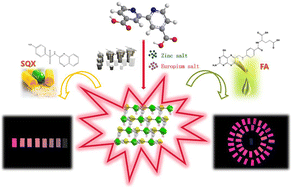Identification of folic acid and sulfaquinoxaline using a heterometallic Zn–Eu MOF as a sensor†
Abstract
A d–f heterometallic MOF using the 2,2′-bipyridine-4,4′-dicarboxylic acid ligand (H2LZ) was obtained by solvothermal synthesis, namely [EuZn(LZ)2(HCOO)(H2O)3]n (1). The structure analysis shows that compound 1 comprises heterometallic Zn2+ and Eu3+ ions, which are connected by LZ2− and HCOO− anions to form a three-dimensional framework. MOF 1 exhibited high stability of fluorescence intensity in the scope of pH 2–11 in an aqueous solution. Furthermore, MOF 1 served as an excellent selective sensing material for the detection of folic acid in the presence of some imitating materials of the human body and discerned sulfaquinoxaline in sulfonamide drugs with high sensitivity, selectivity, and reusability. Moreover, we designed and manufactured a sensor paper based on MOF 1 as a portable device for the visual detection of folic acid and sulfaquinoxaline. More crucially, this is the first example in which luminescent MOF is used to identify sulfaquinoxaline molecules in an aqueous solution. In addition, the luminescence sensing mechanisms of MOF 1 for the detection of the above analytes were explored in detail.



 Please wait while we load your content...
Please wait while we load your content...